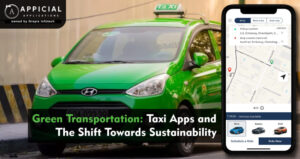
With growing pollution and congestion in cities around the world, ride-sharing applications are fast emerging as key contributors in the quest for greener, more sustainable cities. By reducing the number of private vehicles on the road and promoting shared transportation options, these apps are playing a pivotal role in driving environmental change. Here’s how ride-sharing apps are contributing to greener cities and shaping a sustainable future for urban transportation:
Reducing Traffic Congestion
Amongst the major challenges for cities in the form of enhanced emissions and time being wasted, carpooling or sharing of rides is facilitated by such apps, which help solve this problem. By matching passengers headed in the same direction, it reduces the number of vehicles on the road, eases up the traffic flow, and thereby reduces the overall travel time.
Key benefits include:
- Fewer Vehicles: Carpooling options decrease the number of required cars, hence reducing congestion in traffic.
- Efficient Routes: The algorithms working behind every ride-sharing app work for efficient routing for faster and quick travels.
Lowering Emissions
Probably the biggest environmental advantage of these ride-sharing applications is carpooling, which brings a reduction in carbon emission. Shared rides along with eco-friendly vehicle options, provided by ride-sharing services, lower the collective carbon footprint from urban transport.
How Ride-Sharing Apps Reduce Emissions:
- Carpooling: Sharing rides with others means fewer cars on the road, directly reducing emissions.
- Eco-Friendly Vehicles: Many ride-sharing companies are adding electric and hybrid vehicles to their fleets, promoting cleaner transportation options.
Encouraging Sustainable Transportation
Ride-sharing apps are at the forefront of promoting sustainable transportation choices. By providing accessible, convenient, and cost-effective alternatives to private car ownership, these services encourage more people to opt for greener modes of transport.
Sustainable Choices Offered:
- Electric Vehicles (EVs): Some ride-sharing platforms offer exclusive EV options, making it easier for users to choose eco-friendly rides.
- Bike and Scooter Sharing: Integration with bike and scooter-sharing services encourages users to choose zero-emission transportation for short trips.
Optimizing Urban Mobility
Ride-sharing apps play a crucial role in optimizing urban mobility by integrating various modes of transportation into a seamless user experience. This integration helps create a more efficient and sustainable transportation ecosystem.
Integrated Mobility Solutions:
- Public Transit Partnerships: Ride-sharing apps often partner with public transit systems to provide last-mile connectivity, making it easier for commuters to access public transportation.
- Dynamic Routing: Real-time data and advanced algorithms help optimize routes and reduce travel time, enhancing the efficiency of the urban transportation network.
Promoting Shared Economy Principles
The rise of ride-sharing apps has contributed to the growth of the shared economy, which emphasizes the importance of resource-sharing to minimize waste and maximize efficiency. This shift towards shared services is essential for building sustainable cities.
Benefits of the Shared Economy:
- Resource Optimization: Carpooling reduces the need to own new vehicles, thus conserving resources and decreasing emissions from manufacturing processes.
- Community Building: Carpooling puts into a single car those whose transportation routes and needs overlap.
Supporting Urban Planning and Development
It is true that ride-sharing could offer valuable information to urban planners as well as policymakers. As cities analyze the demands of travel patterns, this indeed gives them a substantial material on which to base infrastructural development and transportation planning in developing more sustainable urban environments.
How Data Supports Urban Planning:
- Travel Pattern Analysis: Knowing where people travel and when helps in devising appropriate transportation networks for improved, congestion-free flow of commuters.
- Infrastructure Investments: Data-driven insights guide investments in public transit, road networks, and other infrastructure projects to support sustainable urban growth.
Conclusion
Ride-sharing applications make huge strides in forming greener cities because of less congestion on traffic, low emissions, more feasibility of sustainable transportation, and optimization of urban mobility. As technology continues to evolve, these apps will go a long way in shaping the future ahead. By embracing ride-sharing along with other shared economy principles, cities can move toward a more sustainable, efficient, and environmentally friendly future.
